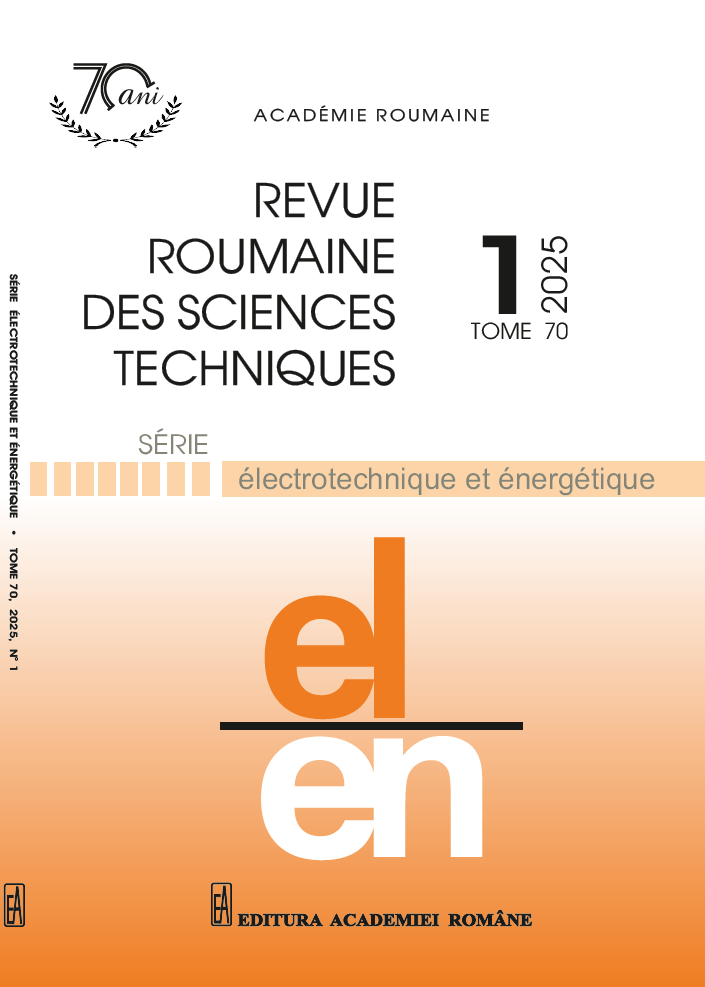POWER FLOW BALANCE – SIMULATIONS AND EXPERIMENTS IN ELECTRICAL NETWORKS
DOI:
https://doi.org/10.59277/RRST-EE.2025.1.9Keywords:
Distribution grid, Active power, Reactive power, Unbalanced consumers, Nonlinear consumers, Symmetrical components power theory (SCPT), Powers of symmetry, Powers of non-symmetry, Residual (distorting) powers, Waveforms, Harmonics, Numerical simulationAbstract
This paper provides a detailed analysis of the effects of electric power transfer in distorted and asymmetric regimes specific to three-phase, four-wire systems by analyzing and exposing the negative influence of nonlinear and unbalanced consumers on the other grid-connected consumers and the power line. A key aspect of this study is to investigate the impact of these regimes on the parasitic active and reactive powers, which affect linear and balanced consumers due to distorted and unbalanced loads. The quantitative evaluation of the phenomena involved is carried out through the symmetric component power theory (SCPT), introduced by Acad. Andrei Țugulea, allowing the identification of the source of the non-symmetry and residual powers. This approach is consistent with the experimental data acquired in our previous research, proving the validity of SCPT. Circuit simulation was done with SPICE software, confirming the consistency between the data acquired experimentally and those provided by the numerical simulation.
References
(1) D.R. Corrêa, A. Silva de Morais, F.L. Tofoli, Non-isolated quadratic SEPIC converter without electrolytic capacitors for LED driver applications, 15th Brazilian Power Electronics and 5th IEEE Southern Power Electronics Conference, pp. 1–7 (2019).
(2) Y. Wang, J.M. Alonso, X. Ruan, A review of LED drivers and related technologies, IEEE Trans. Ind. Electron., 64, 7, pp. 5754–5765 (2017).
(3) C.C. Raicu, G.C. Seritan, B. Enache, 48 V network adoption for automotive lighting systems, Rev. Roum. Sci. Techn. – Électrotechn. et Énerg., 66, 4, pp. 231–236 (2021).
(4) G. Vacheva, N. Hinov, B. Gilev, Computer investigation of SEPIC DC-DC converter for LED lighting applications, Second Balkan Junior Conference on Lighting, pp. 1–4 (2019).
(5) J. Singh, P. Mahajan, R. Garg, Design & implementation of solar fed intensity-controlled streetlight, 2nd IEEE International Conference on Power Electronics, Intelligent Control, and Energy Systems, pp. 671–676 (2018).
(6) S. Ahmad, N.M.L. Tan, M.Z. Baharuddin, G. Buticchi, A high-performance isolated SEPIC converter for non-electrolytic LED lighting, in IEEE Access, 9, pp. 149894–149905 (2021).
(7) V. Naithani, A.N. Tiwari, S. Dobhal, Simulation of SEPIC converter fed LED’s, International Journal of Engineering Science and Technology, 4, 3, pp. 1015–1020 (2012).
(8) S. Singh, B. Singh, Single-phase SEPIC based PFC converter for PMBLDC motor drive in air-conditioning system, Asian Power Electronics Journal, 4, 1, pp. 16–21 (2010).
(9) D.S.L. Simonetti, J. Sebastian, J. Uceda, The discontinuous conduction mode SEPIC and CUK power factor pre-regulators: analysis and design, in IEEE Trans. on Industrial Electronics, 44, 5, pp. 630–637 (1997).
(10) A. Sureshkumar, R. Gunabalan, Design and implementation of single switch control DC-DC converter with wide input variation in automotive LED lighting, Int. Trans. Elect. Energy Syst., 31, 4 (2021).
(11) M. Dalla Vecchia, G. Van den Broeck, S. Ravyts, J. Tant, J. Driesen, A family of DC–DC converters with high step-down voltage capability based on the valley-fill switched capacitor principle, in IEEE Transactions on Industrial Electronics, 68, 7, pp. 5810–5820 (2021).
(12) S. Hariprasath, R. Balamurugan, A valley-fill SEPIC-derived power factor correction topology for LED lighting applications using one cycle control technique, International Conference on Computer Communication and Informatics, IEEE (2013).
(13) H. Ma, C. Zheng, W. Yu, J.-S. Lai, Bridgeless electrolytic capacitor-less valley fill AC/DC converter for twin-bus type LED lighting applications, 1st International Future Energy Electronics Conference, pp. 304–310 (2013).
(14) D. Dah, C. Lu, Analysis of an AC-DC valley-fill power factor corrector, ECTI Transactions on Electrical Eng., Electronics, and Communications, 5, 2 (2007).
(15) N. Molavi, H. Farzanehfard, Load-independent hybrid resonant converter for automotive LED driver applications, in IEEE Trans. on Power Electronics, 377, pp. 8199–8206 (2022).
(16) Z. Zhang, J. Lin, Y. Zhou, X. Ren, Analysis and decoupling design of a 30 MHz resonant SEPIC converter, in IEEE Transactions on Power Electronics, 31, 6, pp. 4536–4548 (2016).
(17) A. Ţugulea, Power flows under non-sinusoidal and non-symmetric periodic and almost periodic steady states of electrical power system, Proc. of 6th Int. Conf. On Harmonics in Power Systems (ICHPS VI), Bologna, Italy, pp. 388–395 (1994).
(18) A. Ţugulea, Criteria for the definition of the electric power quality and its measurement systems, European Transactions on Electrical Power, 6, 5, pp. 357–363 (1996).
(19) R.M. Ciuceanu, I.V. Nemoianu, V. Mănescu (Păltânea), G. Păltânea, On professor Ţugulea’s visionary power theory: a review, recent advances and perspectives, Roum. Sci. Techn. – Électrotechn. et Énerg., 63, 2, pp. 123–127 (2018).
(20) I.V. Nemoianu, R.M. Ciuceanu, Non-symmetry and residual active and reactive powers flow in non-linear three-phase unbalanced circuits, Roum. Sci. Techn. – Électrotechn. et Énerg., 60, 2, pp. 227–237 (2015).
(21) I.V. Nemoianu, R.M. Ciuceanu, Characterization of non-linear three-phase unbalanced circuits powers flow supplied with symmetrical voltages, Roum. Sci. Techn. – Électrotechn. et Énerg., 60, 3, pp. 355–365 (2015).
(22) B.D.H. Tellegen, A general network theorem, with applications, Philips Res. Rep., 7, pp. 259–269 (1952).
Downloads
Published
Issue
Section
License
Copyright (c) 2025 REVUE ROUMAINE DES SCIENCES TECHNIQUES — SÉRIE ÉLECTROTECHNIQUE ET ÉNERGÉTIQUE

This work is licensed under a Creative Commons Attribution-NonCommercial-NoDerivatives 4.0 International License.


